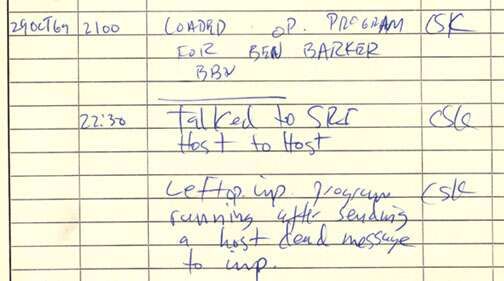Editor’s Note: A simple, two-line entry into an academic activity log at UCLA 50 years ago today helped mark the Internet’s rather inconspicuous beginnings – when it was still being developed as ARPANET technology and wasn’t yet available for use by academics and researchers – let alone public, commercial applications.
2012 Internet Hall of Fame inductee Leonard Kleinrock was leading the team at UCLA responsible for this two-line entry, dated October 29, 1969, which undramatically stated, “Talked to SRI Host to Host.” This straightforward memo belied the event’s eventual impact: it was, in fact, the very first connection two computers had made in the experimental network.

That first connection ultimately crashed, but the global Internet that resulted has gone on to create billions of connections among people all over the world. In ways both good and bad. On the anniversary of that first connection, Dr. Kleinrock has shared with us his thoughts about where the Internet will take us, and what the next iteration will look like.
On July 3, 1969, four months before the first message of the Internet was sent, I was quoted in a UCLA press release in which I articulated my vision of what the Internet would become. Much of that vision has been realized (including one item I totally missed, namely, that social networking would become so dominant). But there was a critical component of that vision which has not yet been realized. I call that the invisible Internet. What I mean is that the Internet will be invisible in the sense that electricity is invisible – electricity has the extremely simple interface of a socket in the wall from which something called electricity is provided reliably and invisibly. Well, the Internet is anything but invisible as yet. Its interface often includes a clumsy, sometimes tiny, keyboard, using a small screen displaying characters that may be smaller than my aging eyes can accommodate and applications that incorporate navigation tools which are clumsy, nonstandard, and frustrating.
Such an invisible Internet will provide intelligent spaces. When I enter such a space, it should know I entered and it should present to me an experience that matches my privileges, profile, and preferences. These spaces can be any location on earth, i.e., my room, my desk, my automobile, my fingernails, my body, my favorite shopping mall, London, or even the Dead Sea. Moreover, I should be able to interact with that space using human friendly interfaces such as speech, gestures, haptics and, eventually, brain-to-Internet interfaces. Indeed, what I am talking about is characterized by a pervasive global nervous system across this planet. The Internet will be everywhere and it will be invisible.
Technology is moving us forward toward such an invisible Internet as we deploy the Internet of Things in our physical space. It takes the form of embedded devices consisting of sensors, actuators, logic, memory, communications, microphones, speakers, cameras, and displays. This is where physical devices disappear into the infrastructure. Moreover, we are also beginning to deploy intelligent software agents acting on our behalf, and customized to our desires; they provide alerts, information, suggestions, and act on our behalf. They could also be useful in enforcing the privacy policy we expect to be applied to us when we access web-based services.
We recognize that such an environment is a highly distributed network of intelligent devices and agents and we may well see the application of blockchain-distributed ledger technology to help implement this invisible Internet.